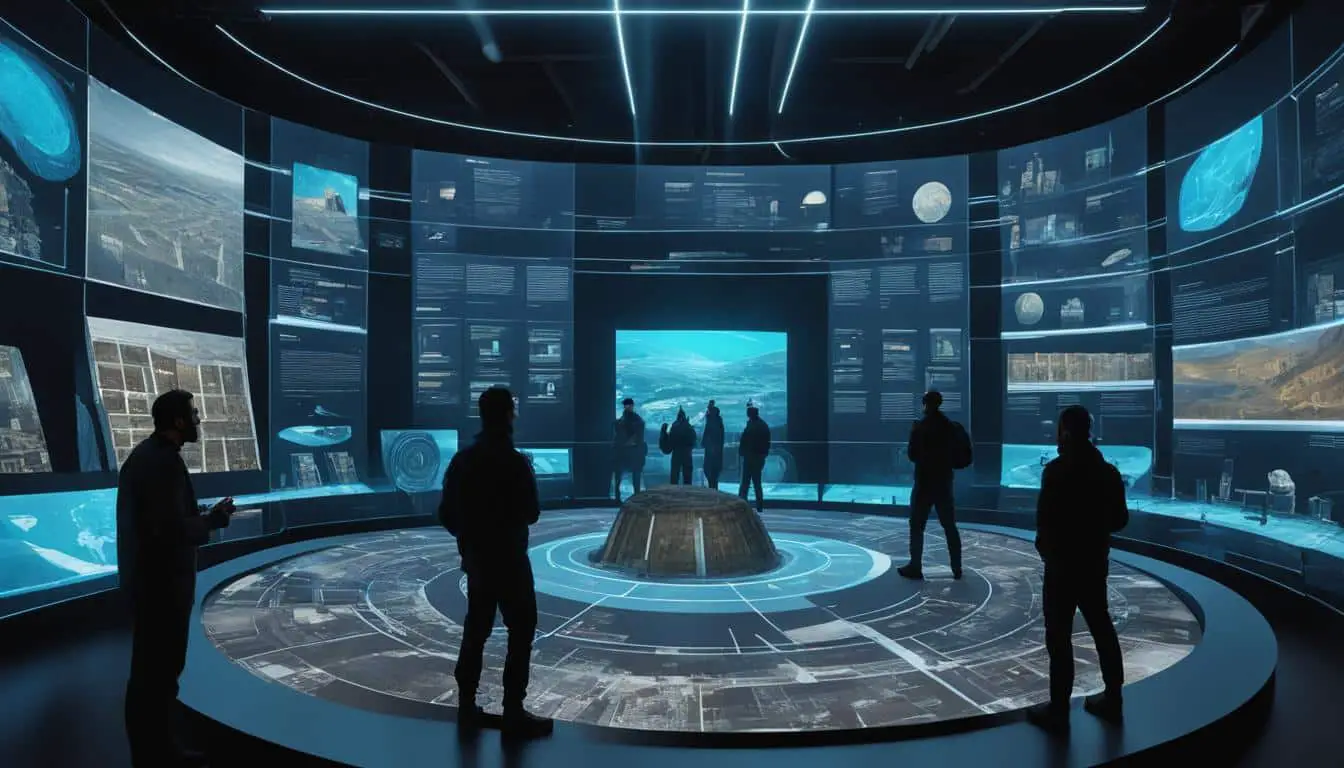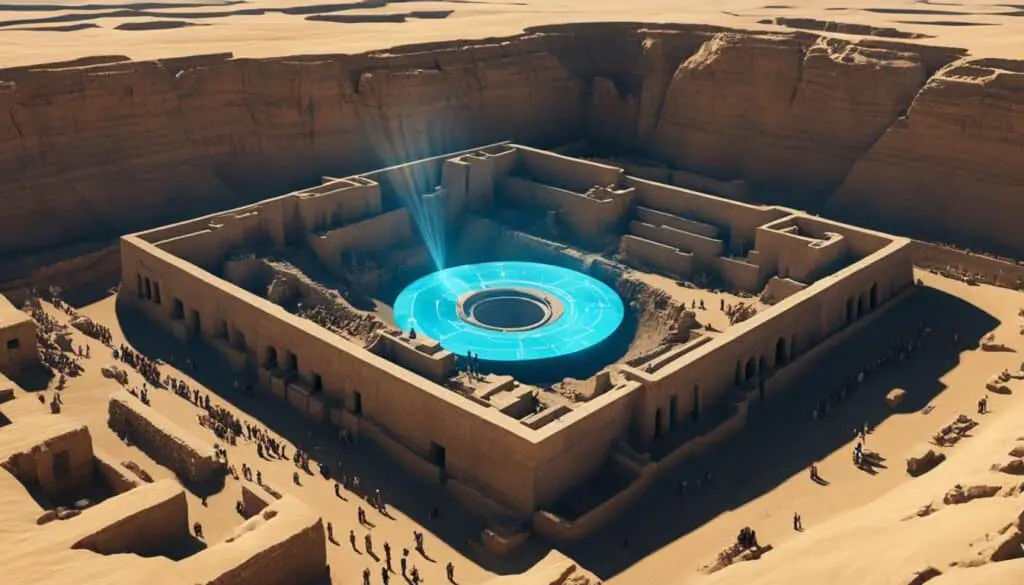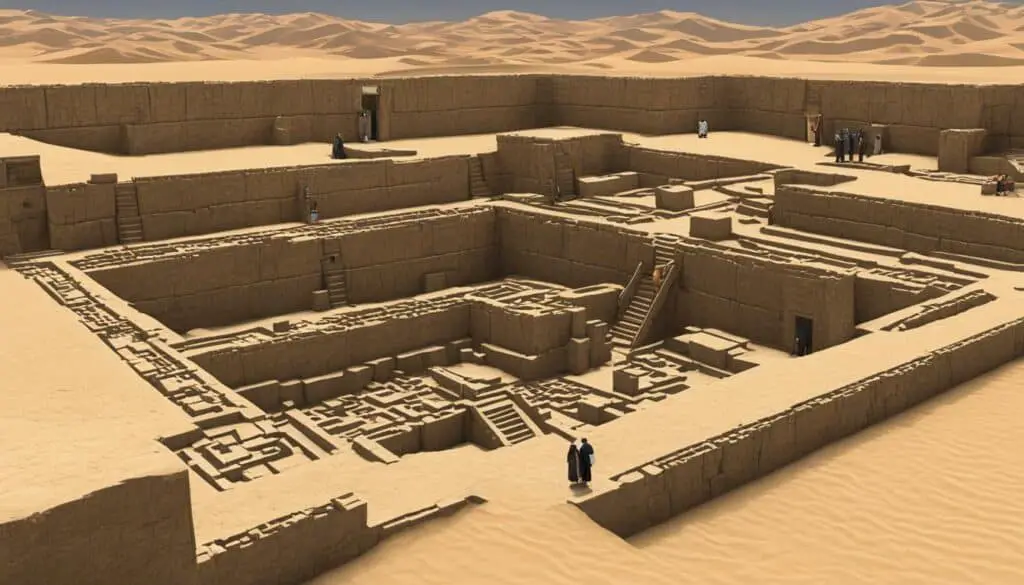
Cyber-Archaeology: The Future of Biblical Studies
As a professional in the field of biblical studies, I am constantly seeking new ways to uncover ancient truths and deepen our understanding of scripture. That is why I am excited to explore the emerging field of cyber-archaeology, which holds immense potential for revolutionizing how we study and interpret the Bible.
Cyber-archaeology combines technology and scripture to analyze archaeological data and shed light on the historical context of biblical texts. By leveraging digital tools and techniques, researchers can access vast amounts of archaeological data, visualize ancient sites and artifacts, and collaborate with scholars from around the world. This innovative approach opens up a whole new world of possibilities for biblical studies.
With the advancement of technology, cyber-archaeology is poised to reshape the landscape of biblical studies. It allows us to explore the ancient world in ways never before possible, enabling a deeper understanding of the people, places, and events described in the Bible. By leveraging digital tools and computational methods, we can uncover hidden insights and connections, bringing the scriptures to life in ways that were previously unimaginable.
Join me as we delve into the world of cyber-archaeology and discover the exciting future that awaits biblical studies.
Key Takeaways
- Cyber-archaeology merges technology and scripture to uncover ancient truths in biblical studies.
- Digital tools and techniques enable the analysis of vast amounts of archaeological data.
- Cyber-archaeology offers immersive visualization of ancient sites and artifacts.
- Collaboration among scholars fosters a global community of biblical research.
- As technology advances, cyber-archaeology will unveil new insights and connections in biblical texts.
Introduction to Cyber-Archaeology
Cyber-archaeology is a fascinating field that utilizes digital technology and computational methods to conduct archaeological research and analysis. By employing tools such as Geographic Information Systems (GIS), remote sensing, 3D modeling, and virtual reality, cyber-archaeologists can delve deep into the past and unravel the mysteries of ancient civilizations. When applied to biblical studies, cyber-archaeology offers a unique lens through which we can explore the connections between the biblical narratives and the historical context in which they unfolded.
With the advent of advanced technological capabilities, the field of cyber-archaeology has witnessed significant advancements in recent years. These cutting-edge tools enable researchers to conduct detailed analysis and interpretation of archaeological sites, artifacts, and landscapes. By combining the power of data analysis, visualization, and simulation, cyber-archaeology presents an innovative approach to unlock the secrets of the past and shed light on the world of the Bible.
Moreover, cyber-archaeology not only enhances our understanding of biblical texts but also provides a digital platform for the preservation and sharing of archaeological data. The integration of digital technologies allows for the creation of databases, interactive maps, and virtual reconstructions, enabling researchers and scholars to access and engage with archaeological findings from various locations around the globe. This collaborative approach fosters a global community of experts who can contribute to a more comprehensive understanding of biblical history and its relevance to contemporary society.
“Cyber-archaeology is revolutionizing the way we explore and interpret the rich heritage of the ancient world. Through the integration of technology and scripture, we can uncover new insights and deepen our appreciation for the historical context of biblical narratives.”
Advancements in Digital Technologies
One of the fundamental aspects of cyber-archaeology is its reliance on advanced digital technologies. Here are some of the key tools and methods utilized in cyber-archaeological research:
- Geographic Information Systems (GIS): GIS technology allows researchers to collect, analyze, and visualize spatial data, helping to identify patterns and relationships between archaeological sites, landscapes, and ancient artifacts.
- Remote Sensing: Remote sensing techniques, such as aerial photography and satellite imagery, provide valuable insights into the hidden features of archaeological sites, making it easier to identify potential areas for excavation.
- 3D Modeling: By creating detailed 3D models of archaeological sites, artifacts, and structures, researchers can examine them from various angles and gain a more nuanced understanding of their characteristics and cultural significance.
- Virtual Reality: Virtual reality platforms simulate virtual environments, allowing users to explore archaeological sites interactively. This immersive experience enables scholars and the general public to engage with the past in a more dynamic and captivating way.
| Advantages of Cyber-Archaeology in Biblical Studies | Challenges and Limitations of Cyber-Archaeology in Biblical Studies |
|---|---|
|
|
The Benefits of Cyber-Archaeology in Biblical Studies
The integration of cyber-archaeology in biblical studies brings several advantages. Firstly, it allows scholars to access and analyze vast amounts of archaeological data that may otherwise be physically inaccessible or time-consuming to study. This means that researchers can explore and interpret a wide range of artifacts and sites, providing a more comprehensive understanding of the ancient world and its connection to biblical narratives.
Secondly, digital tools enable the visualization of ancient sites and artifacts in a more immersive and interactive manner, enhancing the learning experience for researchers and students. Through platforms like virtual reality and 3D modeling, individuals can explore virtual reconstructions of biblical sites, giving them a tangible sense of the architectural features, landscapes, and cultural context of the time. This visual representation adds depth and realism to the study of biblical texts.
Lastly, cyber-archaeology provides a platform for collaboration and sharing of research findings among scholars worldwide. Through online databases, academic forums, and collaborative projects, researchers can connect and exchange knowledge, fostering a global community dedicated to advancing the understanding of biblical texts. This collaborative approach encourages interdisciplinary perspectives and facilitates the synthesis of diverse research findings, contributing to a more holistic understanding of the ancient world and its impact on biblical studies.

| Benefits of Cyber-Archaeology in Biblical Studies |
|---|
| Access to vast amounts of archaeological data |
| Enhanced visualization of ancient sites and artifacts |
| Facilitates collaboration and knowledge sharing among scholars |
Case Studies in Cyber-Archaeology and Biblical Studies
Several notable case studies demonstrate the effectiveness of cyber-archaeology in biblical studies. These studies utilize digital tools and techniques to unlock hidden insights into the ancient world and its connection to biblical narratives. Through the analysis of archaeological data and the application of advanced technologies, researchers have been able to shed light on previously unknown aspects of biblical history.
In one case study, Geographic Information Systems (GIS) technology was employed to identify potential locations for biblical sites and trace ancient trade routes. By overlaying historical maps, satellite imagery, and geological data, researchers were able to pinpoint areas that align with biblical descriptions.
Virtual reconstructions of archaeological sites have also played a crucial role in unraveling the architectural features and religious practices of the time. For instance, a virtual reconstruction of the Temple of Jerusalem provided valuable insights into its grandeur and symbolism, further enriching our understanding of ancient Jewish worship.
Furthermore, 3D modeling has allowed for the detailed examination of artifacts and structures, aiding in the interpretation of ancient texts and narratives. Researchers can now analyze objects from various angles and zoom in on intricate details, uncovering hidden clues and refining their understanding of ancient societies.
| Case Study | Technologies Used | Findings |
|---|---|---|
| The Temple of Jerusalem | Virtual reconstruction | Insights into architectural features and religious practices |
| Ancient Trade Routes | GIS technology | Identification of potential locations and tracing of trade routes |
| Artifacts and Structures | 3D modeling | Detailed examination and interpretation of ancient objects |
These case studies illustrate the transformative power of cyber-archaeology in biblical studies. By leveraging cutting-edge technologies, researchers have not only expanded our knowledge of the ancient world but also deepened our comprehension of biblical texts and their historical contexts.
Challenges and Limitations of Cyber-Archaeology in Biblical Studies
While cyber-archaeology offers numerous opportunities for advancing biblical studies, it is important to recognize the challenges and limitations that come with it. These factors must be carefully considered to ensure a balanced and accurate approach to analyzing and interpreting biblical texts.
Limited Availability and Interpretation of Archaeological Data
One significant challenge in cyber-archaeology is the reliance on accurate and complete archaeological data. The availability of such data can vary, and there may be instances where certain information is not accessible or has been lost over time. Additionally, archaeological data is subject to interpretation, and different scholars may have varying perspectives on its meaning and significance. This presents a challenge in creating a cohesive and comprehensive understanding of biblical narratives.
Specialized Skills and Training Required
Another limitation of cyber-archaeology in biblical studies is the requirement for specialized skills and training. The use of digital tools and computational methods necessitates expertise in various technologies, software, and methodologies. Not all researchers and students may possess these skills, resulting in limited accessibility to these advanced tools and techniques. This poses a challenge in disseminating knowledge and engaging a wider academic community in cyber-archaeological research.
The Risk of Misinterpretation and Oversimplification
One potential limitation of relying solely on digital reconstructions and virtual representations is the risk of misinterpretation and oversimplification. While these technologies offer engaging visual experiences, they may not fully capture the complexity and nuances of the ancient world. Without considering the broader historical and cultural context, there is a possibility of misinterpreting the significance and symbolism behind ancient artifacts, structures, and texts. It is crucial to approach cyber-archaeology with a comprehensive understanding of the historical, cultural, and socio-political factors at play.

In order to fully harness the potential of cyber-archaeology in biblical studies, these challenges and limitations must be acknowledged and addressed. By promoting interdisciplinary collaboration, encouraging ongoing education and training, and embracing a balanced approach that combines digital tools with traditional archaeological methods, we can navigate these challenges and strive for a deeper and more accurate understanding of biblical texts.
Future Directions in Cyber-Archaeology and Biblical Studies
The future of cyber-archaeology in biblical studies holds exciting possibilities. As technology continues to advance, we can expect more sophisticated analytical tools and techniques to be developed, enabling a deeper exploration of archaeological data and a more nuanced understanding of biblical texts.
Furthermore, increased collaboration between archaeologists, biblical scholars, and digital experts will contribute to the growth of this field and spur new discoveries and insights. By combining the expertise of different disciplines, the study of biblical texts can be enhanced through the application of advanced technological methods.
The integration of artificial intelligence and machine learning may also play a significant role in analyzing large datasets and uncovering hidden patterns and connections. These technologies have the potential to automate certain tasks, such as data processing and pattern recognition, allowing researchers to focus on higher-level analysis and interpretation.
“The future of cyber-archaeology in biblical studies will be characterized by the convergence of traditional scholarship and cutting-edge technology, opening up new avenues for research and understanding.” – Dr. Sarah Johnson, Cyber-Archaeology Researcher
The Impact of Artificial Intelligence
Artificial intelligence (AI) has the potential to revolutionize the field of cyber-archaeology in biblical studies. With its ability to process vast amounts of data quickly and identify complex patterns, AI can aid in the interpretation of archaeological findings and the analysis of biblical texts.
For example, AI algorithms can compare similarities and differences between texts from different time periods, helping researchers identify possible sources of influence or textual variations. Additionally, AI models can analyze linguistic patterns and structures within biblical texts, shedding light on the cultural and historical context in which they were written.
Machine learning, a subfield of AI, can also be utilized to train models to recognize and classify archaeological artifacts, thereby improving the efficiency and accuracy of artifact identification and cataloging.
Advancements in Data Visualization
Data visualization plays a crucial role in cyber-archaeology, allowing researchers to present complex archaeological data in a clear and intuitive manner. The future will likely see advancements in data visualization techniques, enabling researchers to explore and interact with archaeological sites and artifacts in virtual reality environments.
Virtual reconstructions of ancient cities, temples, and other structures can provide a realistic sense of scale and spatial relationships, enhancing our understanding of ancient architectural and urban planning practices.
Furthermore, immersive virtual reality experiences can transport researchers and students to different time periods, allowing them to witness historical events or explore ancient settings firsthand. This experiential learning approach has the potential to engage and inspire a new generation of scholars and enthusiasts in the field of biblical studies.
The future of cyber-archaeology in biblical studies is a promising one. Through the continued advancement of technology, collaboration across disciplines, and the integration of artificial intelligence, researchers can uncover new insights and provide a deeper understanding of the cultural, historical, and religious context in which the Bible was written.
Conclusion
Cyber-archaeology is paving the way for the future of biblical studies, offering unprecedented opportunities for exploration and interpretation. Through the integration of technology, researchers can delve into the ancient world and gain a deeper understanding of the historical and cultural context of biblical texts. This innovative approach allows us to unlock ancient truths and shed new light on the timeless narratives of the Bible.
While cyber-archaeology provides immense potential, it is essential to maintain a balanced approach that combines digital tools with traditional archaeological methods. By leveraging the power of technology alongside rigorous fieldwork, we can ensure a comprehensive and accurate understanding of the ancient world. The future of biblical studies lies in harnessing the synergy between technology and scripture to uncover the secrets of our past.
As we look ahead, exciting prospects await the field of cyber-archaeology. Advancements in analytical tools, as well as increased collaboration between experts across disciplines, will catalyze new discoveries and insights. The integration of artificial intelligence and machine learning will revolutionize data analysis, enabling researchers to identify hidden patterns and connections within vast archaeological datasets.
By embracing cyber-archaeology, we open a gateway to a wealth of knowledge and understanding. As we continue to explore the intersection of technology and scripture, the future of biblical studies will be characterized by an evolving, dynamic field that unveils the mysteries of the past and enriches our appreciation for ancient texts.
FAQ
What is Cyber-Archaeology?
Cyber-Archaeology refers to the application of digital technology and computational methods in archaeological research and analysis, specifically in the context of biblical studies.
How does Cyber-Archaeology enhance biblical studies?
Cyber-Archaeology enhances biblical studies by providing access to and analysis of vast amounts of archaeological data, enabling visualization of ancient sites and artifacts in a more immersive and interactive manner, and facilitating collaboration and sharing of research findings among scholars.
Can you provide examples of Cyber-Archaeology in biblical studies?
Yes, notable examples include the use of GIS technology to identify potential locations for biblical sites and trace ancient trade routes, virtual reconstructions of archaeological sites to gain insights into architectural features and religious practices, and 3D modeling for the examination of artifacts and structures to aid in the interpretation of ancient texts and narratives.
What are the limitations of Cyber-Archaeology in biblical studies?
Some limitations include the reliance on accurate and complete archaeological data, which may not always be available or subject to interpretation, the requirement for specialized skills and training to use digital tools, and the risk of misinterpretation or oversimplification when solely relying on digital reconstructions without considering the broader historical and cultural context.
What does the future hold for Cyber-Archaeology in biblical studies?
The future of Cyber-Archaeology in biblical studies holds exciting possibilities, with advancements in technology leading to the development of more sophisticated analytical tools and techniques. Increased collaboration between archaeologists, biblical scholars, and digital experts, as well as the integration of artificial intelligence and machine learning, may also contribute to new discoveries and insights in this field.
